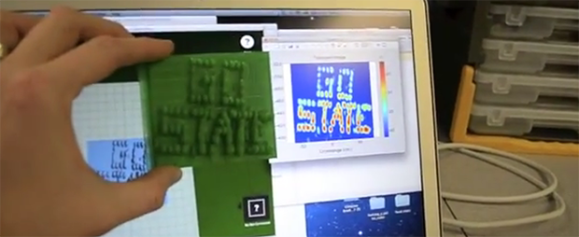
What could possibly be better than printing out a few low-resolution voxels on a MakerBot? A whole lot of things, but how about getting those voxels with your own synthetic aperture radar? That’s what [Gregory Charvat] has been up to, and he’s documented the entire process for us.
The build began with an ultra wideband impulse radar we saw a while ago. The radar is built from scraps [Greg] picked up on eBay, and is able to image a scene in the time domain, creating nice linear sweeps on a MATLAB plot when [Greg] runs in front of the horns.
With an impulse radar under his belt, [Greg] moved up the technological ladder to something that can produce vaguely intelligible images with his setup. The synthetic aperture radar made from putting his radar horns on the carriage of a garage door opener. The horns slowly scan back and forth along the linear rail, taking single impulse readings and adding them together in an image. In the video below, [Greg] is able to image a few pieces of copper pipe only a few inches in diameter. The necessary equipment for this build only cost [Greg] a few hundred bucks at the Dayton Hamvention, and a similar setup could be put together for even less.
If building an X band impulse synthetic aperture radar isn’t impressive enough. [Greg] also 3D printed one of his radar images on a MakerBot. That’s just applying stlwrite to the 2D radar image and feeding it into MakerWare. Gotta have that blog cred, doe. It also makes for the best headline I’ve ever written.















If you are looking for a way to get radar images into STLs I wrote a JavaScript/HTML5 engine for converting black and white images to 3d surfaces, then wrapping those surfaces to a cylinder or sphere in open scad (all files generated dynamically with little interaction). Yes i have some bugs left to hash out (IE the aspect ratio doesn’t adjust to your image).
But it is availible here,
http://camerinhahn.com/image_to_surface.html
sources is here
https://github.com/camerin/Image_to_surface
I have used it several times to make lithophanes. Have fun
Fair warning, if you set it up strangely there is no limit to the number of files your computer will generate for you to download. I didn’t write it to be idiot proof
While not being able to map on circles. Cura is able to directly open image files and convert them to lithophanes on the fly.
Very very cool! I really wanted to see the unprocessed image with range arcs and all that before the processed image. What software are you using to deconvolve the whole thing? Are you collecting quadrature data and using phase?
I only recently found out the transducers being sold to turn tables and windows into speakers are magnetostrictive and I can finally finish a long range DIY chirped SA SONAR. I will need to do basically the same processing.
(Subtracting a background image is kind of sneaky :-)
Always a sign that you’re doing something cool in the garage when the car is pulled out! :)
Nice finds at the Dayton Hamvention!!!! Not just for ham radio stuff… They have just about everything And it’s next week!
May 16-18, Hara Arena, Dayton, OH
http://www.hamvention.org